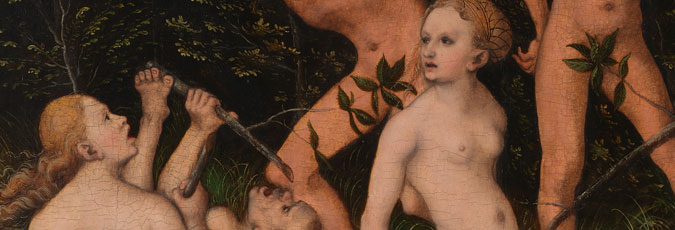Subject
Three naked women with children and four fighting men are set against a grassy foreground and a thick frieze of foliage, extending on the left almost to the top of the picture. The central and right-hand parts of the hedge are lower, revealing a landscape background of tall mountains with distant buildings in the centre and on the far right. The men form two pairs: on the left a man holding a still leafy wooden stake lies on the ground with blood streaming down his back, his mouth open in pain; he is being beaten by a standing bearded man with a long stick. On the right lies a bearded man who has evidently just been beaten to the ground by the white-bearded man standing over him, who holds a long leafy stick. In the foreground, on the left, a woman turns open-mouthed to look at the scene, herself holding a stick with the sharper end upwards, as if to defend herself or one of the men. Another woman, standing centrally and clasping the wrists of two babies, appears to be speaking to her. In the right-hand corner of the picture, apparently oblivious to the fighting behind her, a woman reclines in the grass with her baby; it looks up at her over her shoulder, while the baby behind reaches down as if to grab its hair or pluck some grass.
Other paintings by Cranach with similar subjects
NG3922 is one of a small group of pictures by Cranach dated between 1527 and 1535 which show fighting between groups of naked men, but also include naked women and children. The National Gallery picture has the fewest figures of these compositions. The earliest known dated composition of this type is the painting at Weimar, dated 1527.8 Further examples are: a painting in the Louvre, dated 1535 (fig. 2),9 a painting dated 1529 now at Schaffhausen and the painting dated 1530 in the Pushkin Museum (see Versions).10 The latter, which Levey called ‘vaguely related’ includes a woman being snatched by a man. A picture of men fighting with women on the left and one being seized was in the Joly de Bammeville sale in 1850.11 None of the figures is repeated exactly in the other versions of this type of composition. A metalpoint drawing at Berlin (fig. 3), sometimes attributed to Hans Cranach, which is often discussed in connection with this group of paintings, shows two men fighting with sticks and a seated woman with a baby not dissimilar to the woman and baby in the foreground of the National Gallery picture. However, the Berlin work also includes a satyr taking the arm of a woman and a man with a lionskin.12 A painting at Münster (fig. 4) may be linked to the theme of the fight presented here and in other paintings: it appears to show a man with a club and a woman quarrelling, with other women present.13
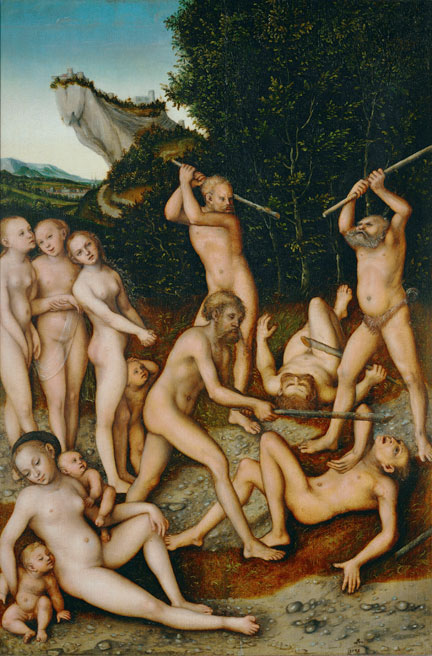
The subject of NG3922 and similar pictures has been much debated.14 First described in the nineteenth century as showing men fighting, the pictures (including this example) were then called ‘The Effects of Jealousy’, by analogy with an erroneous interpretation of Dürer’s engraving of 'Hercules at the Crossroads' of about 1498.15 Most twentieth-century art historians have assumed the origins of the subject must lie in a classical text.
Classical texts as possible sources for the subject
1. Hesiod
Flechsig first proposed in 1900 that the subject of these pictures ultimately derived from the ancient Greek author Hesiod’s account of the evolutionary ages of man. He suggested that the subject might have come to Cranach’s attention via some version of the text made by a German humanist poet at the Wittenberg court, which could account for the lack of any real relationship between the Greek text and Cranach’s pictures.16 No such text has to date been found, although an edition of Hesiod was first published in 1493, and the Venetian Aldus Manutius published an edition in 1495; the electors of Saxony procured publications from the Aldine Press. In his 'Erga' ('Works') Hesiod gave an account of the ‘Ages of Man’, Golden, Silver, Bronze and Iron, with an age of heroes interpolated between the last two. He described the people of the Silver Age as weak and lacking in consideration for each other and for the gods and creatures such as fauns and satyrs.17 Levey pointed out that Hesiod’s account of the quarrelsome end to the Silver Age had little to do with the action taking place in the National Gallery picture. However, following Flechsig, he thought it possible that an intermediary source for the National Gallery picture, perhaps a Latin text ‘by a contemporary Wittenberg versifier’, might have suggested to Cranach the representation of a fight between the Silver Age people and those of the more warlike Bronze Age. Some of the protagonists carry spears and the vanquished men seem to have skin lighter in tone than the victors, who could therefore be men of bronze. It is possible, however, that the skin colour of these warriors may have more to do with Cranach’s attempts to create the effects of distance in the middle ground of the composition. Moreover, the passage in Hesiod which might be interpreted as referring to ashen spears has rather been interpreted by most commentators as describing a race of men born of ash trees.18
2. Ovid
Hesiod’s description of the early development of the human race was one of several such accounts given in classical literature.19 In the sixteenth century the best known of these was without doubt that narrated in Ovid’s 'Metamorphoses.'20 Ovid’s description of the Ages of Man, like those of a number of other classical authors, outlined a progressive deterioration from a Golden Age, in which the uncultivated earth freely provided produce to sustain the human race. The Silver Age brought the seasons and agricultural cultivation, while the Bronze Age people were fiercer. The Iron Age saw the introduction of trade, mining, warfare and domestic strife. A number of sixteenth-century depictions of the Silver Age were produced as illustrations to Ovid, and have little in common with Cranach’s paintings: in these works the figures are clothed, have shelters and are engaged in agricultural activities (fig. 5). Depictions of the Bronze Age show warriors fighting, but they are dressed in armour (fig. 6).21 In the National Gallery picture the people are naked and have only tree branches with which to fight. In the distant background are castles and other dwellings of some grandeur which cannot be those of the unclothed quarrelling protagonists. If this detail is not merely to be taken as a characteristic element of Cranach’s landscape backgrounds, it might add some weight to the argument that the subject derives from Ovid. In that case the work could be a depiction of forest dwellers living in the Bronze or Iron Ages, when building techniques had been mastered, who are clearly living a life apart, as they are not themselves using metal weapons.22 However, Ovid says nothing to suggest that the forest dwellers fought among themselves.23
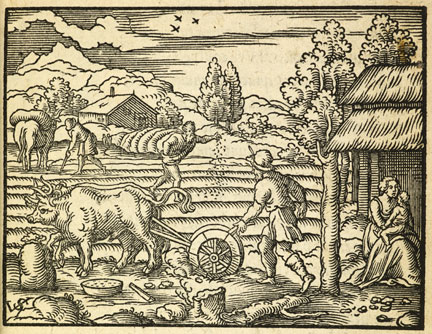
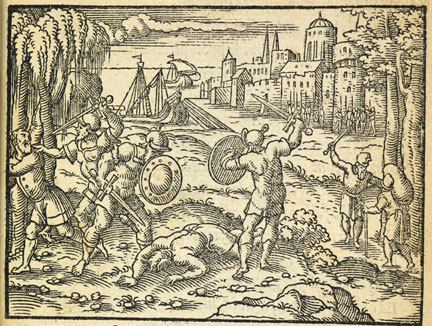
3. Lucretius
If the castles are disregarded as anachronistic elements of the background, another classical source that can be considered is the 'De Rerum Natura' ('On the Nature of Things') of Lucretius. The Roman author has also been suggested as a possible source for Cranach’s paintings of forest dwellers who are in some pictures clearly fauns or satyrs, with pointed ears or cloven feet, but in others indistinguishable from the unclothed people in the ‘Silver Age’ compositions.24 Rediscovered by fifteenth-century Italian humanists, 'De Rerum Natura' has been considered to be the source for a series of paintings by Piero di Cosimo representing primitive people, as well as for other Italian works.25 According to Lucretius, the life of early man was distinguished by discomfort, rather than the bounty available to Golden Age inhabitants in the writings of other classical authors, and was gradually improved. In one passage he describes how men’s fierce behaviour mellowed after they took women as their mates and produced children.26 Although Lucretius says here that these primitive people now wore animal skins, which the people in Cranach’s paintings do not, this passage seems particularly close to his composition, in which the innocent presence and charm of women and children is emphasised. It would also account for the fact that some of the women and children seem unconcerned by the fighting, which would be particularly inappropriate if unknown invaders were fighting with members of their families.
However, knowledge of Lucretius was not widespread in the early sixteenth century, and there appears to have been no visual tradition associated with his text, which was regarded as dangerously anti-religious.27 Lucretius appears rather to have been mediated through Vitruvius, whose writings on architecture became known in Germany in the later 1520s. There was a visual tradition associated with Vitruvius, and Piero di Cosimo’s paintings may have drawn on this, rather than direct knowledge of Lucretius.28 German woodcut illustrations to Vitruvius show groups of naked people in families similar to Cranach’s. However, like Piero di Cosimo’s works, they tend to focus on the discovery of fire, which is not the subject of any of Cranach’s paintings.
The theme of ‘primitive people’
Koepplin and Falk have stressed the importance of considering Cranach’s groups of fighting men in the context of those works of his which represent primitive people as well as fauns and satyrs.29 Early sixteenth-century visualisations of a primitive world included fauns, satyrs and forest dwellers. Their origins can be traced to knowledge of classical texts familiar in medieval times, such as those by Virgil and Ovid, as well as to the legendary semi-bestial ‘wild people’, well known in the Middle Ages, with their origins in pagan beliefs and ceremonies.30 A passage in Ovid’s 'Metamorphoses', following the account of the four ages referred to above, includes a speech in which Jupiter favours destroying the Iron Age people in order to protect the fauns, satyrs and other forest dwellers; the latter may have been identified in Cranach’s time with the ‘wild people’ often depicted in the late Middle Ages, and apparently still of great interest to Cranach’s contemporaries.31 In Virgil’s 'Aeneid' there is a short passage in which the Golden Age is described as populating a woodland area in which fauns, nymphs and men sprung from the trunks of trees already flourished.32 It has been assumed that paintings by Cranach of people bathing and disporting themselves alongside animals and fruit trees represent the Golden Age described by Hesiod and other classical writers, but those pictures have more in common with medieval representations of the earthly paradise. Their horizontal format is also quite different from the vertical format of his depictions of fighting men, satyrs and other forest dwellers; it is unlikely that the two series of subjects are related.33
The theme of NG3922 and similar paintings can be most clearly understood in the context of the representation of primitive people and their forest-dwelling companions. As first suggested by Koepplin and Falk at the time of their Basel Cranach exhibition in 1974, the so-called ‘Silver Age’ paintings should be known by the title ‘Primitive People’.34 There was no single textual or visual means by which these images were transmitted, but contemporary visual parallels for such themes are found in Dürer’s engraving of a satyr family of 1505 or Altdorfer’s painting of wild people of 1507 at Berlin.35 The theme of ‘wild people’ had been used in many types of decoration by German artists (for example, as supporters for coats of arms, as seen on the shutters of Dürer’s 'Portrait of Oswald Krell' in the Alte Pinakothek, Munich) and also by Cranach himself in an early tournament woodcut (fig. 7). The figures in NG 3922 in particular, with their flowing beards and the carefully decorative arrangement of their leafy branches, resemble the wildmen motifs used by Cranach and earlier decorative artists, ‘freed’ into paintings, as the Basel exhibition suggested.36 However, Cranach’s figures look less wild than Dürer’s in his engraving, or Altdorfer’s in his painting, perhaps because of the more open setting and because the figures themselves are carefully arranged, with only some of them active. The fighting men in the National Gallery picture consist of only two pairs, as in the version formerly in Berlin, which is arranged on a diagonal, rather than the more frieze-like arrangement which Cranach has favoured here. In the Weimar picture, the figures are arranged in the most ambitious manner, deliberately showing backs contrasted with fronts and foreshortened figures lying on the ground with heads lying in contrasting directions. These figures are highly reminiscent of the famous engraving of fighting men by Pollaiuolo (fig. 8) and appear to be adapted from this source.37
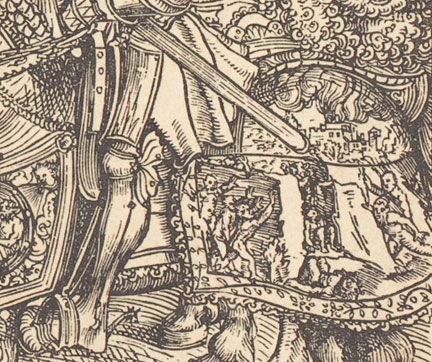
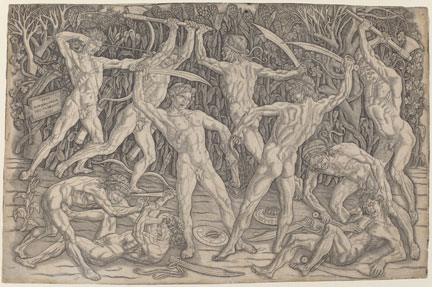
Possible pendants
The compositions portraying primitive people were not much repeated, by contrast with other subjects depicted by Cranach, such as Venus and Cupid (see NG6511). In addition to the variants of NG3922 mentioned above, there exists a small group of paintings depicting a faun family with a slain lion.38 They must, however, have been intended to appeal to the same market for which Dürer, Altdorfer and other German artists such as Burgkmair produced images of primitive people. It has been suggested that when one or more of Cranach’s pictures was hung in the domestic settings for which they must have been intended, their meaning would have been reinforced by their surroundings, by the contrast or tension between the representation of uncivilised life within the picture and civilised life around it.39 It is also possible that some of these paintings were designed to be hung together as a series or as pendants.40 It has been proposed, for example, that 'Apollo and Diana' (Royal Collection) might have been a pendant to the Weimar picture of fighting men (although it is also very close in size to NG3922) and that this might also have been intended to be hung with a representation of a faun family and a Venus and Cupid.41 One possible occasion for which such a group of paintings of very high quality might have been produced was the marriage of the future Elector Johann Friedrich the Magnanimous to Sibylla of Cleves in 1527.42
But these resemblances might simply be the product of Cranach’s method of reproducing and varying this theme. There are similarities in the treatment of the landscape: for example, the rocky crag, the buildings reflected in water, the thick curtain of leaves and the stag’s head in 'Apollo and Diana' are all closely comparable to the National Gallery 'Venus and Cupid' (NG6511). The thematic links between the forest, the world of hunting and of fauns, nymphs and primitive people seem to have inspired a group of exceptionally beautiful paintings from the mid-1520s. Such paintings might have had resonance both for the hunting-obsessed Saxon courtiers as well as for those close to the interests of German humanists such as Conrad Celtis who associated the German forest with the origins of the primitive German people, mediated through texts such as Tacitus’s 'Germania'.44 Likewise, those whose fascination with ‘primitive people’ was stimulated in Germany in the early sixteenth century by the accounts of newly discovered lands beyond Europe may well have looked to these works with interest.45
Further sections
- Introduction
- Provenance, exhibitions, versions, and copies
- Technical notes
- Subject
- Attribution and date
9. Friedländer and Rosenberg 1978, no. 265B. This picture was offered to the National Gallery in 1894 by Peter Cooper: letter in NG dossier. Levey refers to this as another version of the NG picture but records in the Louvre dossier confirm that this is indeed the painting acquired by the Louvre.
10. Friedländer and Rosenberg 1978, nos 265 and 265A.
11. A similar painting was described in Schuchardt’s collection in Weimar in 1851 (Schuchardt 1851, no. 420), tentatively associated in the catalogue with a painting dated 1531 sold at Sotheby’s, London, 15 April 1999 (37) (style of Cranach, Vice and Virtue), which appears to be a version of the Pushkin painting; a similar painting was sold at auction in Paris in July 2006. I am grateful to Gunnar Heydenreich for this information.
12. Levey 1959, p. 22, noted that this was sometimes called ‘The Silver Age’ and suggested that this might not be correct. Flechsig 1900, p. 249 mentions a version formerly in the Lippmann collection, Vienna.
13. Friedländer and Rosenberg 1978, no. 200.
14. Levey 1959. Much of what follows in this catalogue entry was published in Foister 2003.
15. Heller 1844, p. 80, cited in Levey 1959, pp. 21–2. NG 3922 was sold from the Habich collection in 1892 under this title.
16. Flechsig 1900, pp. 268–9.
17. Hesiod, Works, Loeb edn, 1954, p. 13, cited by Levey 1959, note 29.
18. See Lovejoy and Boas 1935, p. 29.
19. For a comprehensive account of this subject see Lovejoy and Boas 1935.
20. Ovid, Metamorphoses, book I, lines 100–50.
21. Examples include a series of prints by Virgil Solis, published in 1557 as illustrations to Ovid, and other such prints, including one in a 1582 Leipzig edition of Metamorphoses illustrated by Johann Steinnar, with engravings by Tempesta. A series of drawings in Antwerp by Marten de Vos depicts the Silver Age as a young woman with agricultural implements and the Bronze Age as a figure in armour.
22. Koepplin and Falk 1974, vol. II, p. 598, make a similar point. See also Wood 1993, pp. 152–7, esp. p. 157: towns occur in the background in works by Cranach’s contemporary Altdorfer, when depicting wild people; see also Gaus 1971, esp. pp. 7–15.
23. See Wood 1993, pp. 152–6.
24. Koepplin and Falk 1974, vol. II, p. 599.
25. Panofsky 1972, pp. 33–68. See also Simon 1965.
26. Lucretius, De Rerum Natura, book V, lines 1013 ff. See also Koepplin and Falk 1974–6, vol. II, p. 599, Simon 1965 and Brown 2010, p. 106. I am grateful to Erika Langmuir for drawing my attention to this passage.
27. See Reynolds 1983, pp. 218–22 and further Brown 2010, esp. pp. viii–ix.
28.Although see Brown 2010, p. 105, linking Piero di Cosimo’s work to contemporary Florentine responses to Lucretius.
29. See Koepplin and Falk 1974–6, vol. II, pp. 585–604, esp. pp. 599–600, a discussion of the Weimar version of NG3922.
30. Ibid., pp. 598–9; see also Bonnet 1994, p. 144. For wild people see Bernheimer 1953 and Silver 1983, with further references to literature on this theme, also Wood 1993.
31. Ovid, Metamorphoses, book I, lines 177–98.
32. Virgil, Aeneid, book VIII, lines 314–25, Loeb edn, pp. 80–3.
33. Friedländer and Rosenberg 1978, nos 261–2, citing Hesiod again as the source. Levey 1959, pp. 21 and 23 note 4, stresses that Cranach’s ‘Golden Age’ pictures have little relationship to the ‘Silver Age’ compositions.
34. Koepplin and Falk 1974, vol. II, p. 592.
35. Dürer engraving Bartsch 69, Altdorfer Berlin Winzinger 1975, no. 5.
36. Koepplin and Falk 1974, vol. II, p. 592.
37. Ibid., p. 600. On the interest taken by Pollaiuollo and others in primitivism as an ‘artistic topos’ that could have developed independently of the Lucretian revival, in response to contemporary events and classical influences, see Brown 2010, p. 108.
38. Friedländer and Rosenberg 1978, no. 266 (Donaueschingen), no. 267 (now Getty Museum) and no. 267A (formerly Kisters Collection, Kreuzlingen).
39. Koepplin and Falk 1974, vol. II, p. 600. It has been suggested that there might also have been a Hercules series.
40. Ibid., pp. 585–93 and 600–1. Compare Panofsky 1972, pp. 56–7 and the Piero di Cosimo series.
41. Although the ‘Faun Family’ in the Getty Museum is not the same size: see Koepplin and Falk 1974, vol. II, pp. 600–1. Only the inferior Kisters version of the faun family is similar in size to the NG and Weimar pictures, but it has been cut: see ibid., p. 601, no. 510. It was suggested by Edgar Wind that Cranach’s painting of the faun family in which a lion skin is proffered was intended to be a representation of Fortezza and Charity, a subject Wind identified in other paintings including Giorgione’s Tempesta: Wind 1969.
42. Foister 2007, pp. 59–60. The Courtauld Institute exhibition of 2007 provided an opportunity to bring these paintings together; their visual congruence provided some encouragement to this hypothesis.
44. Bierende 2002, pp. 250–5, especially pp. 254–5, suggests the subject represents battles between the early inhabitants of Saxony and Thuringia as related in medieval chronicles, but does not cite any visual tradition.
45. Silver 1983, pp. 5–8.

